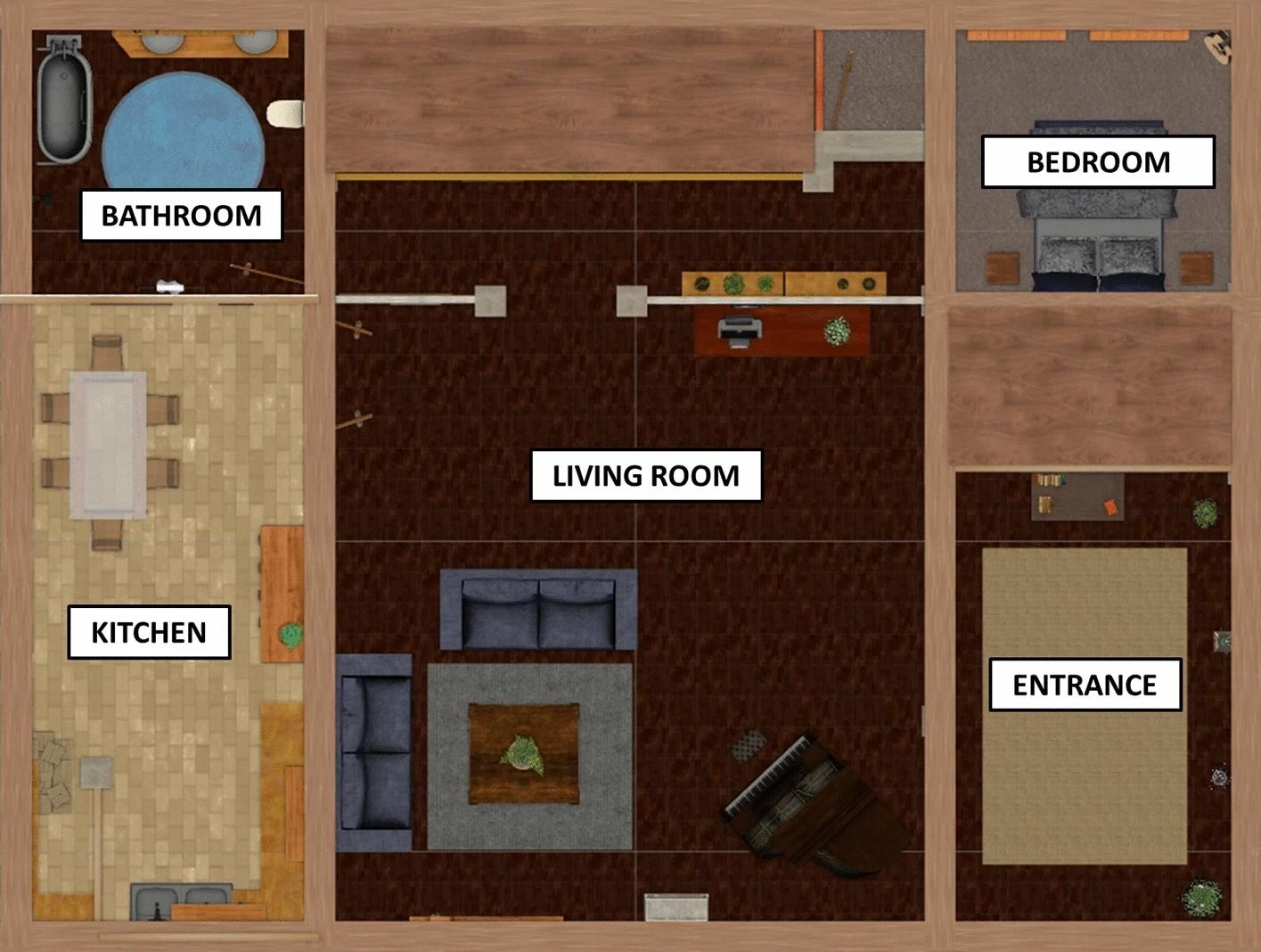In an article published in the journal Scientific Reports, researchers from France investigated how motor interactions with objects affect the memory of large-scale spaces. They used immersive virtual reality (VR) to create a realistic environment where participants had to learn the positions of different items.
 Top view of the virtual environment developed for this study, with the name of each part as mentioned during the training phase. Study: https://www.nature.com/articles/s41598-024-53239-1
Top view of the virtual environment developed for this study, with the name of each part as mentioned during the training phase. Study: https://www.nature.com/articles/s41598-024-53239-1
Moreover, they highlighted that physically reaching and grabbing the items led to more distortions and compression of the spatial representation than simply seeing the items appear in position. The study also found that manipulable items, such as tools, induced more compression than non-manipulable items, such as animals or plants.
Background
Spatial cognition is the ability of individuals to perceive, represent, and navigate surrounding space. It involves various sensory, motor, and cognitive processes interacting with the environment and the body. Moreover, it is influenced by the goals and actions of the individual and the characteristics of encountered objects and places.
For example, the perception of distance between the body and an object may vary depending on the availability of a tool that extends reach or the orientation of the object's handle. These effects reflect the role of action possibilities and motor simulation in spatial perception.
However, limited knowledge exists on how motor interactions and object manipulability impact the memory of large-scale spaces, such as rooms or buildings. Previous studies indicate that spatial memory is not a faithful reproduction of the environment but rather a dynamic, multimodal construction integrating various types of information such as landmarks, routes, and actions.
About the Research
In the present paper, the authors designed an immersive VR experiment to test the effect of motor activity and object manipulability on the memory of large-scale spaces. They created a realistic virtual house with five rooms and a corridor, where participants had to learn the positions of 16 items. Half of these were images of manipulable objects, such as tools or utensils, and the other half were images of non-manipulable objects, such as animals or plants. The items were presented in spheres that appeared at specific locations in the house.
The participants were randomly assigned to active and passive conditions. In the active condition, they had to physically reach and grab the items with their hand and drop them at the designated locations. In the passive condition, they only saw the items appear in position without interacting with them. In both conditions, participants used teleportation to move around the house and had to memorize the items and their locations. After the learning phase, contributors were asked to draw a map of the house and to position the items on it. They were also requested to recall the items in a free recall task.
The study utilized a software tool called geometric map drawing analysis (GMDA) to measure the accuracy, correlation, and scale of the spatial representation. Accuracy was computed from pairwise landmark comparisons summarizing the errors in estimating the distances between two objects. Correlation was obtained from bidimensional regression comparing the sketch map coordinates to the actual reference coordinates. Similarly, the scale was measured from bidimensional regression and accounts for the directional scaling error of all distances. The authors analyzed the geometric properties of the sketch maps and compared them to the actual layout of the house.
Research Findings
The outcomes showed that the active condition significantly affected spatial memory compared to the passive condition. Specifically, participants in the active condition recalled the shape of the house less precisely and made more distance errors between items. Moreover, they highlighted more global scaling compression of their representation, meaning that they underestimated the overall size of the house and the distances between the rooms.
The authors also found that object manipulability had a significant effect on spatial memory, regardless of the condition. Manipulable items were associated with more global scaling compression than non-manipulable items, meaning they were remembered as closer to each other and the boundaries of the house. However, object manipulability did not affect the accuracy or the correlation of the spatial representation.
Applications
The research has implications for understanding spatial cognition and memory, as well as for designing VR applications. The study highlighted that motor interactions and object manipulability can influence the metric properties of spatial representations and that these effects are not limited to peripersonal space but extend to large-scale spaces. It also suggested that motor simulation and action possibilities are involved in the encoding and retrieval of spatial information and that they can distort spatial memory in a specific direction.
The authors demonstrated the potential of immersive VR as a tool to study spatial cognition and memory in realistic and controlled settings. VR can create various scenarios and manipulate different factors that affect spatial perception and memory, such as perspective, orientation, landmarks, or actions. It can also measure the spatial behavior and performance of the participants in an objective and precise way.
Conclusion
In summary, the researchers comprehensively explored the effect of motor interactions and object manipulability on the memory of large-scale spaces. They highlighted that physically reaching and grabbing the items led to more distortions and compression of the spatial representation than simply seeing the items appear in position.
The paper illustrated that manipulable items induced more compression than non-manipulable items. These results suggest that motor simulation and action possibilities shape the metric properties of spatial memory and that spatial representations are dynamic and multimodal constructions that integrate various types of information.